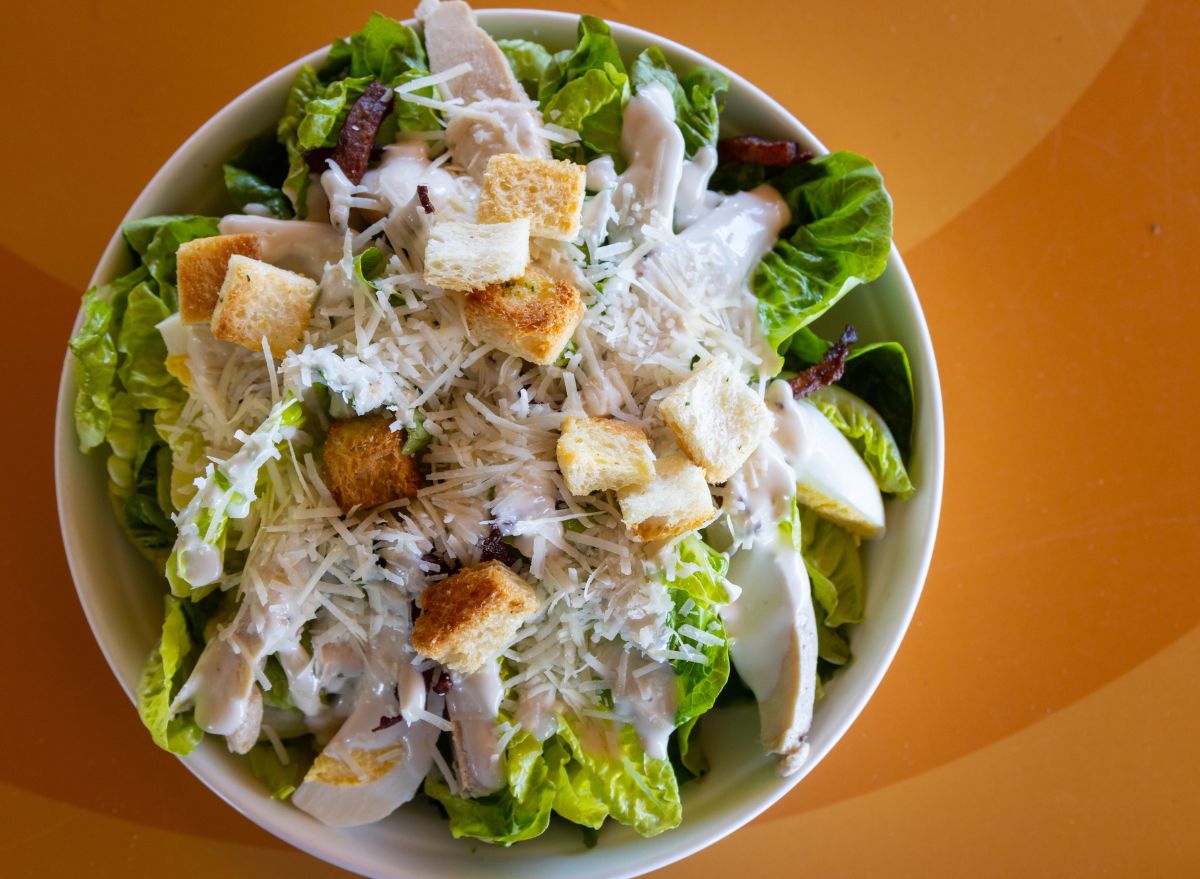“I’ll just have a salad,” used to be a way to let your dinner party know you’re not very hungry, watching your weight, or you’re the only vegetarian at Gallaghers. But, not anymore. Restaurant salads have become gargantuan and not just in serving size, but locked and loaded with all sorts of fatty, high-calorie ingredients that are salty enough to make a sailor blush.
We’re all for filling our plates with crisp vegetables, and you should be, too, but muncher beware: some restaurant salads are so unhealthy, you’d be better off ordering the pork chops. Take our word for it or, better yet, read what registered dietitians have to say about the unhealthiest restaurant salads in America. And if you’re compiling a do-not-eat list, check out The Worst Fast-Food Burgers of All Time, Say Dietitians.
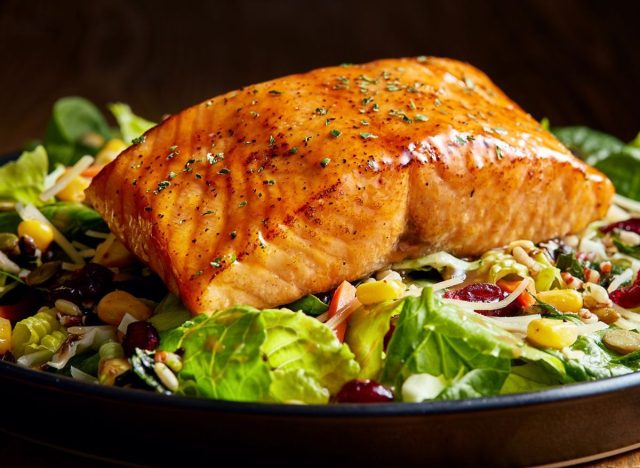
Per salad: 1,040 calories, 53 g fat (11 g saturated, 0 g trans fat) 1,720 mg sodium, 66 g carbs (8 g fiber, 36 g sugar), 52 g protein
“Share this one with two other people,” says Lisa Young, PhD, RDN, author of Finally Full, Finally Slim and member of our Medical Expert Board. Despite the appealing amounts of protein and fiber, this salad contains over 1,000 calories and is too high in sugar and sodium.
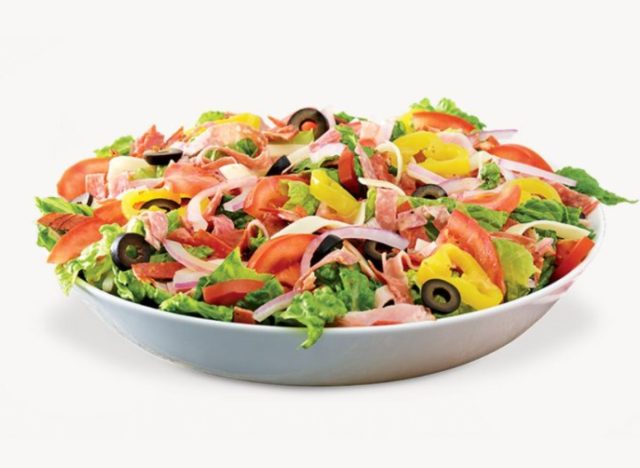
Per salad: 700 calories, 57 g fat (17 g saturated, 1 g trans fat), 2,230 mg sodium, 18 g carbs (5 g fiber, 9 g sugar), 31 g protein
The American Heart Association recommends limiting the amount of saturated fat you swallow to 5 or 6% of your daily calories. For most adults, that works out to be around 13 grams per day. “Unfortunately, this Italian salad is loaded with fat and has four more grams of saturated fat than what the AHA recommends most adults get in one full day,” says registered dietitian nutritionist Mary Wirtz, RDN of Mom Loves Best.
If you pay attention to what’s in the salad bowl here, you can see why it’s so fatty: pepperoni, salami, ham, capicola, and provolone cheese. “This salad is overloaded with ‘ultra-processed’ meats,” says Dr. Young. “The pepperoni and salami are high in fat and sodium. So, I’d skip it.”
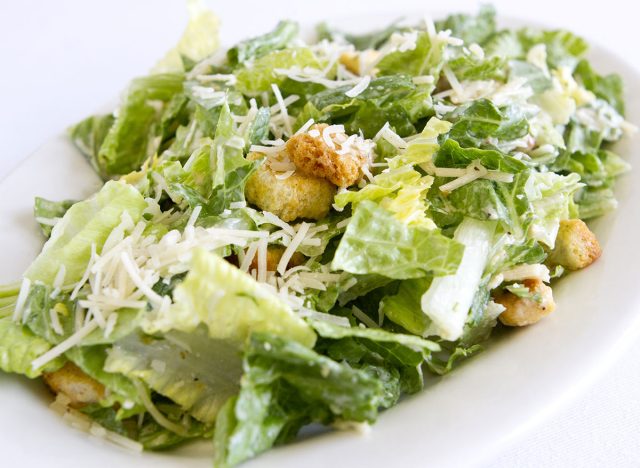
Per salad: 1,050 calories, 66 g fat (15 g saturated, 3 g trans fat), 2,780 mg sodium, 69 g carbs (5 g fiber, 16 g sugar), 48 g protein
Sing “goodbye Ruby Tuesdays Crispy Chicken Caesar,” unless it’ll be your only meal for the next few days. “This salad is a calorie overload,” says Dr. Young. “It contains around a days’ worth of fat and sodium, and is also high in saturated fat. When you see the word ‘crispy’ on a menu, that’s generally a sign to stay away.” Crispy is really just another way of saying deep fried.
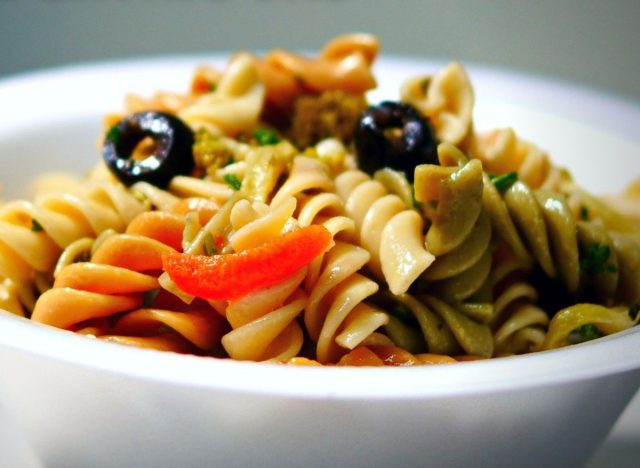
Per 14-ounce salad: 680 calories, 49 g fat (7 g saturated, 0 g trans fat), 1,380 mg sodium, 55 g carbs (6 g fiber, 7 g sugar), 10 g protein
If you are following a 1,500-calorie daily diet for weight loss, the calorie density of Sbarro’s Pasta Primavera Salad is high. “But it’s low in saturated fat and has no trans fat or cholesterol, so a huge portion of the fat is unsaturated, which is good to reduce bad cholesterol in the body,” says Catherine Gervacio, RD, a registered dietitian and nutrition writer for Living Fit. “But, be aware that the calories come primarily from the fat content, so it can cause weight gain when the calories aren’t burned.”
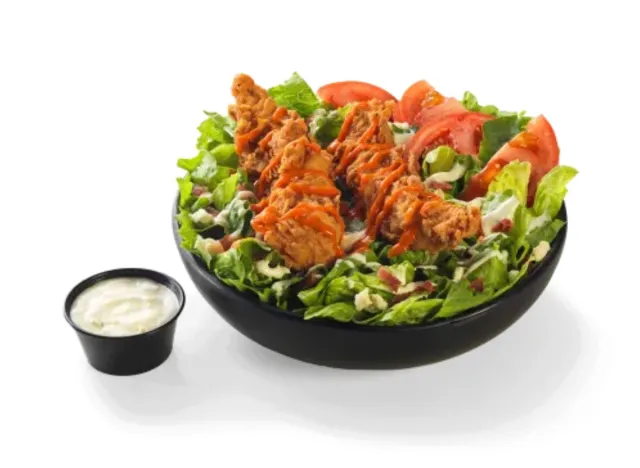
Per salad: 910 calories, 70 g fat (19 g saturated, 1.5 g trans fat), 3,180 mg sodium, 36 g carbs (5 g fiber, 6 g sugar), 35 g protein
“For optimal health, we shouldn’t consume any trans fat and [at most] less than a gram a day,” says registered dietitian Amy Shapiro, RDN, founder of Real Nutrition NYC and a member of our Medical Expert Board. “This salad exceeds that amount in one meal, and doesn’t leave much room for error.” Trans fats are known to decrease the “good” HDL cholesterol and increase the “bad” LDL.
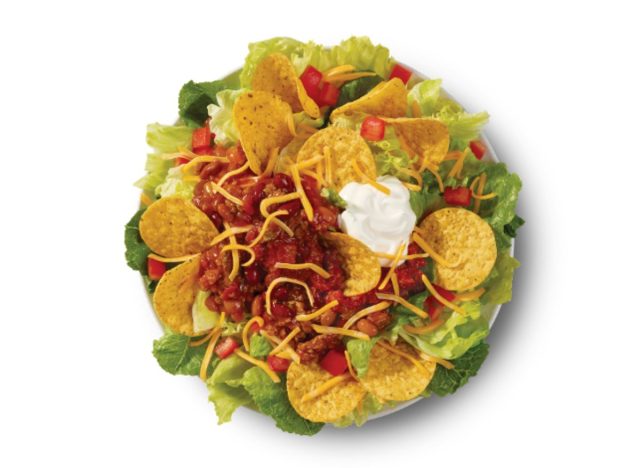
Per salad: 690 calories, 34 g fat, (13 g saturated, 1 g trans fat), 1,870 mg sodium 68 g carbs (12 g fiber, 16 g sugar), 30 g protein
Though high in heart-healthy fiber and muscle-building protein, this salad wouldn’t gain your cardiologist’s approval. “There is 1 gram of trans fat, which is not ideal for those who want to reduce bad cholesterol,” explains Gervacio. “Also, 13 grams of saturated fat elevates the bad cholesterol further, especially since the salad already has 60 milligrams of cholesterol, which is 20% of the recommended daily amount of less than 300 mg.” Other cons for those concerned about metabolic health: 16 grams of sugar and a sodium count that nearly hits the 2,300 milligram AHA limit.
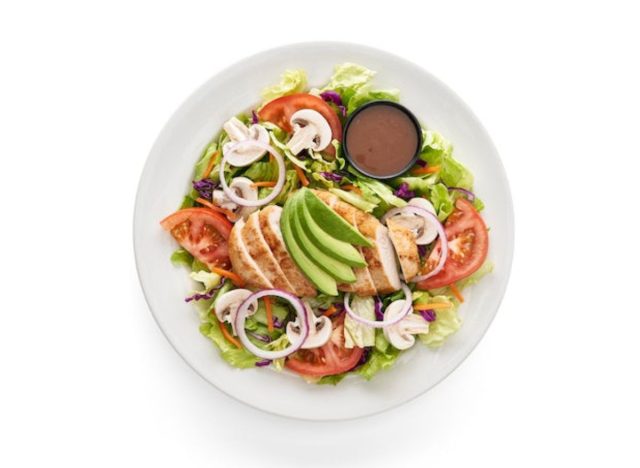
Per salad: 980 calories, 67 g fat, (11 g saturated, 0 g trans fat), 2,180 mg sodium, 56 g carbs (10 g fiber, 27 g sugar), 40 g protein
It all sounds good until you get to the word “with” on the menu. Everything that comes after raises nutritional red flags. “The crispy chicken used in the salad is deep-fried and adds a significant amount of calories to the dish,” notes Trista Best, RD, a registered dietitian with Balance One.
Adding to the calorie count is the honey mustard dressing, which is typically high in sugars and can further contribute to weight gain. “While the salad includes vegetables, the nutritional value of the meal is still relatively low compared to other meal options that include a wider variety of nutrient-dense foods,” says Best.
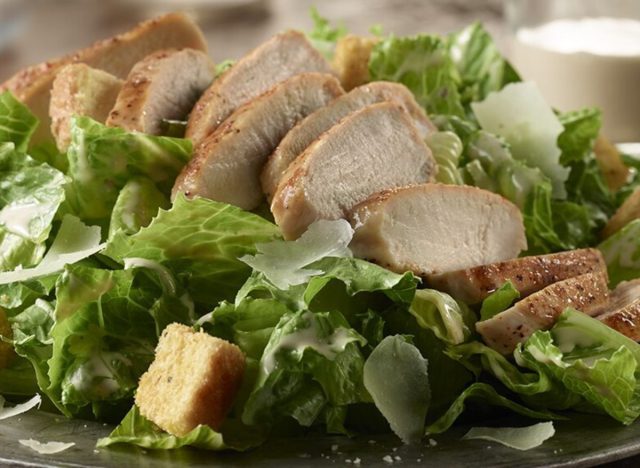
Per salad with salmon: 800 calories, 55 g fat (13 g saturated, 1 g trans fat), 1,150 mg sodium, 26 g carbs (0 g fiber, 3 g sugars, 45 g protein
Per 3-ounce serving of dressing: 350 calories, 34 g fat (7 g saturated, 0 g trans fat), 770 mg sodium, 6 g carbs (0 g fiber, 3 g sugars, 4 g protein
Salmon is a fatty fish, but contains mostly omega-3 fatty acids, so it’s considered low in saturated fat. The 20 grams of the unhealthy saturated fat in this salad come from the oil and cheese components of a traditional Caesar salad, along with the blue cheese dressing. In addition, there’s a gram of trans fat, which is known to contribute to cardiovascular disease, as Gervacio points out above.
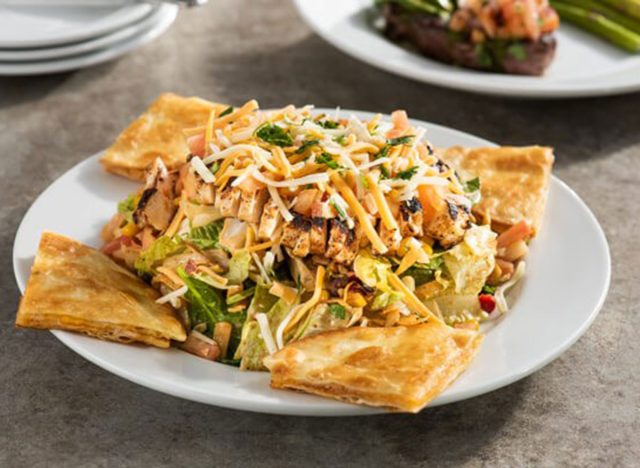
Per salad: 1,190 calories, 89 g fat (24 g saturated, 0 g trans fat), 1,510 mg sodium, 70 g carbs (9 g fiber, 15 g sugar), 55 g protein
At 24 grams of saturated fat, this exceeds the recommended daily amount of saturated fat in a day for the average person, plus it provides more than half of the daily value for calories for someone taking in 2,000 calories a day. “It’s likely the quesadilla component of the salad that tacks on all the calories,” says registered dietitian Amy Goodson, MS, RD, CSSD, LD author of The Sports Nutrition Playbook and member of our Medical Expert Board. “If you like this salad, the best recommendation is to put the dressing on the side, eat only one of the quesadilla triangles, and take the rest home for lunch tomorrow.”
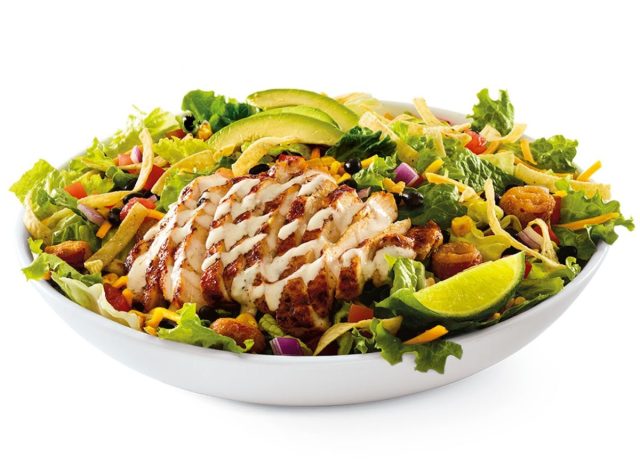
Per salad: 790 calories, 51 g fat (13 g saturated, 1 g trans fat) 1,930 g sodium, 47 g carbs (12 g fiber, 12 g sugar), 42 g protein
The beans, avocado, and vegetables deliver a healthy 12 grams of fiber, but don’t let that fool you. This salad is super high in sodium at 1,850 milligrams, which makes it one of the unhealthiest restaurants salads you can find. “That’s almost a day’s worth of salt,” says Goodson. “And, this salad has two fried components: fried jalapeño coins and tortillas strips, which add on extra fat and saturated fat. This salad itself is a day’s worth of fat for most people, which is not ideal for one meal.”
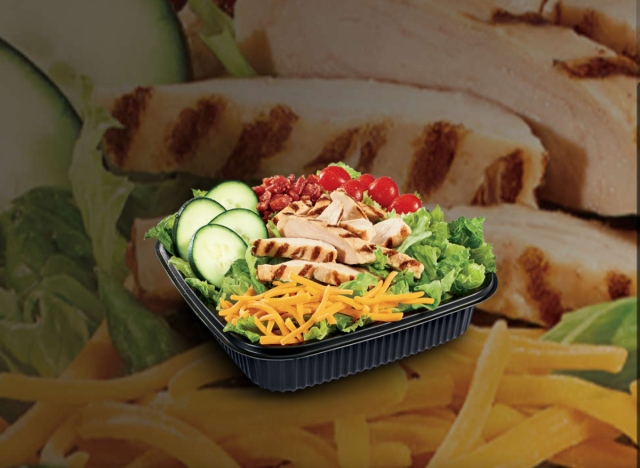
Per salad: 510 calories, 28 g fat (9 g saturated, 0 g trans fat), 1,220 mg sodium, 36 g carbs (5 g fiber, 4 g sugar), 32 g protein
It’s not the worst salad on this list, but it is relatively high in cholesterol at 22% of the recommended daily limit of less than 300 milligrams. “If you choose this salad, you’d have to adjust other meals to not exceed your cholesterol limits,” says Gervacio.
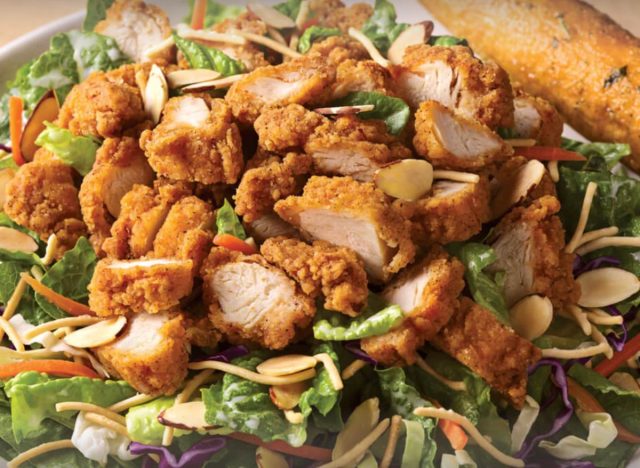
Per salad: 1,560 calories, 103 g fat (17 g saturated, 1 g trans fat), 1,610 mg sodium, 120 g carbs (12 g fiber, 44 g sugar), 40 g protein
With crispy breaded chicken and a breadstick on the side, this salad packs in 103 grams of total fat—making it one of the unhealthiest restaurant salads you can order. “It also contains 44 grams of sugar, likely coming from the Oriental vinaigrette,” says Goodson. “The recommended daily sugar allowance is no more than 10% of daily calorie intake. Looking at an average 2,000-calorie day, this salad would account for 8.5% of total sugar, almost meeting the recommended daily allowance.”
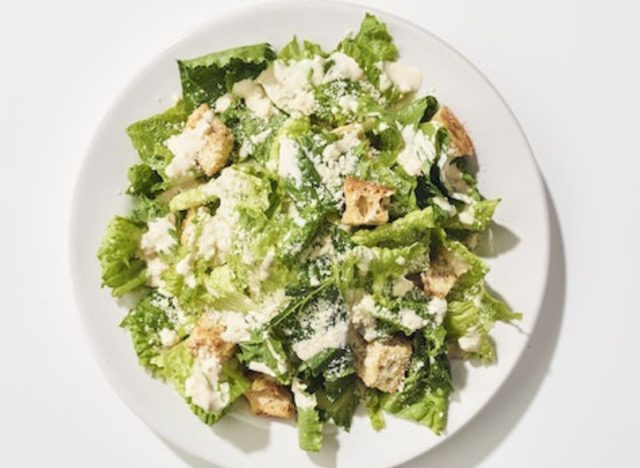
Per salad: 400 calories, 36 g fat (8g saturated, 0.5 g trans fat), 500 mg sodium, 14 g carbs (4 g fiber, 2 g sugar), 7 g protein
Most of the fat in this salad comes from the dressing, and the 8 grams of saturated fat is rather high for a salad. “As an entrée, this salad is fairly low in protein and will not be very filling,” warns Young.
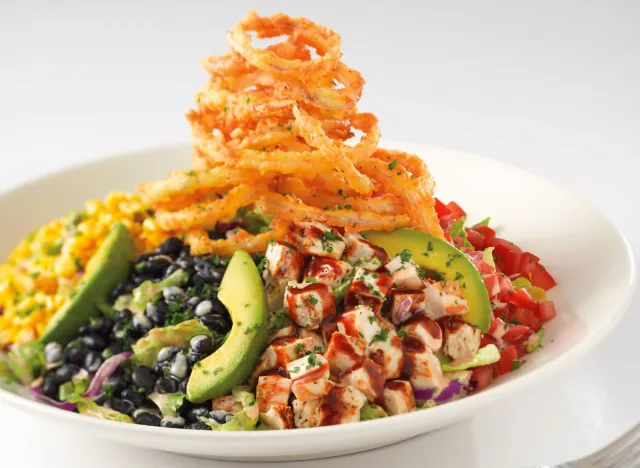
Per salad: 2,150 calories, 137 g fat (25 g saturated, 0 g trans fat), 2,870 mg sodium, 67 g sugars, 66 g protein
A 20-ounce bottle of Crush Orange soda contains 72 grams of sugar. That’ll give you a sense of the sugar content of this “salad.” Most of that sweetness likely comes from the barbecue sauce, which is typically loaded with added sugars. “Foods that are high in sugar and calories can cause a spike in blood sugar levels,” says registered dietitian nutritionist Mary Sabat, RDN, a certified trainer and owner of Body Designs. Unfortunately, high blood sugar over time can lead to insulin resistance.
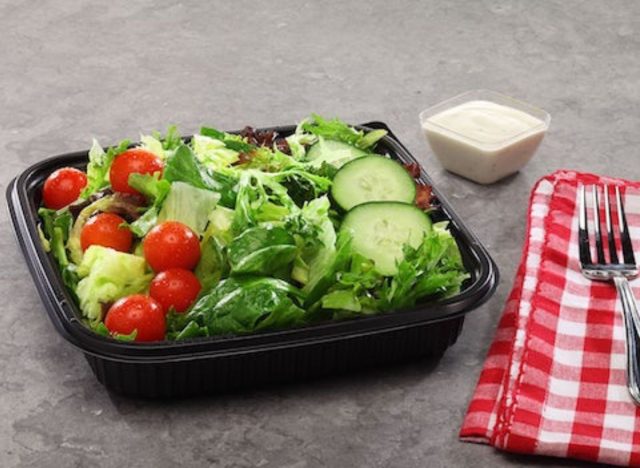
Per 1 cup salad: 180 calories, 12 g fat (2 g saturated, 0 g trans fat), 460 mg sodium, 14 g carbs (2 g fiber, 8 g sugar) 2 g protein
The danger with a buffet-style restaurant like Golden Corral is that it’s easy to overeat, so you must watch your portion sizes. If you choose this marinated salad, take just half a cup and flesh out your plate with proteins and vegetables, or grains for dietary fiber. Alone, this salad won’t provide enough of either to leave you feeling satisfied,” says Wirtz.
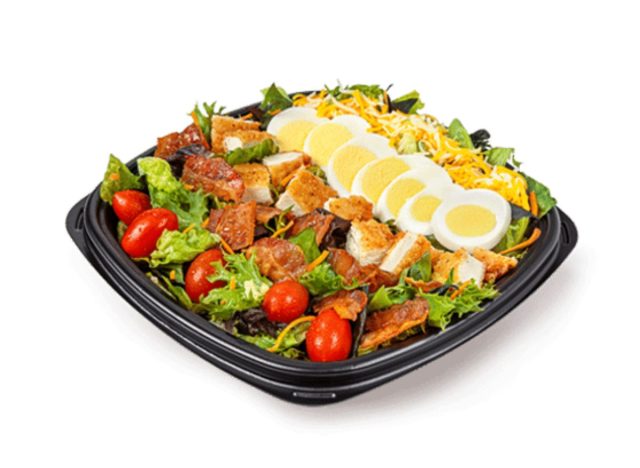
Per salad: 550 calories, 32 g fat (12 g saturated, 0 trans fat), 1,420 mg sodium, 21 g carbs (3 g fiber, 4 g sugar), 43 g protein
One of the best benefits of ordering a salad is helping to meet your daily fiber goals. “This salad won’t help much,” says Shapiro. Other downsides of this unhealthy restaurant salad: High saturated fat for a salad meal. Shapiro recommends asking to hold the cheese and use less dressing to limit the saturated fat.
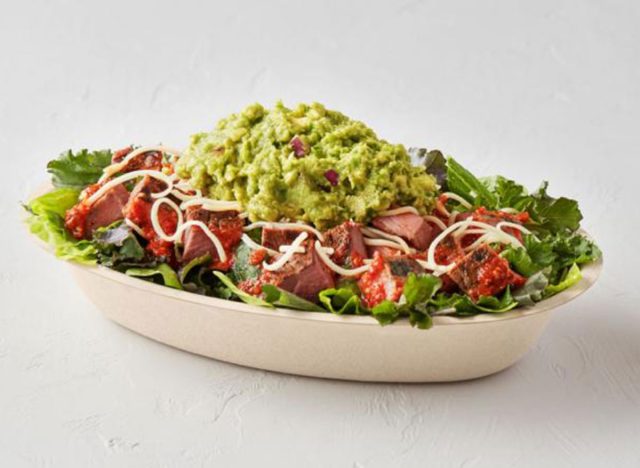
Per salad: 985 calories, 64 g fat, 51 g carbs, 50 g protein
Granted, we loaded this salad down with fatty items, but so do most people who go through the serving line at Chipotle. “I would definitely recommend modifying the choices for this salad,” says Wirtz. That means more beans and veggies, less sour cream and cheese—and to go a little easier on the guacamole.
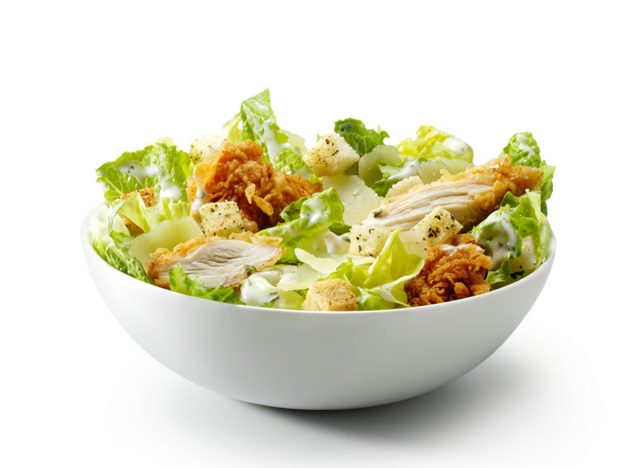
Per salad with dressing and croutons: 360 calories, 31 g fat (6 g saturated, 0 g trans fat), 765 mg sodium, 14 g carbs (1 g fiber, 3 sugar), 7 g protein
The 360 calories don’t seem like a lot compared to most of the salads represented here, that is, until you realize this is a “side” salad meant to go along with a meal. Pay attention to some other words in the name, such as “creamy,” “Parmesan Caesar dressing,” and “croutons.” Each is synonymous with “fat” and “calories.” The 22 grams of fat, along with the calories and fat from the fried chicken, may cause the meal to be unhealthy, says Best.
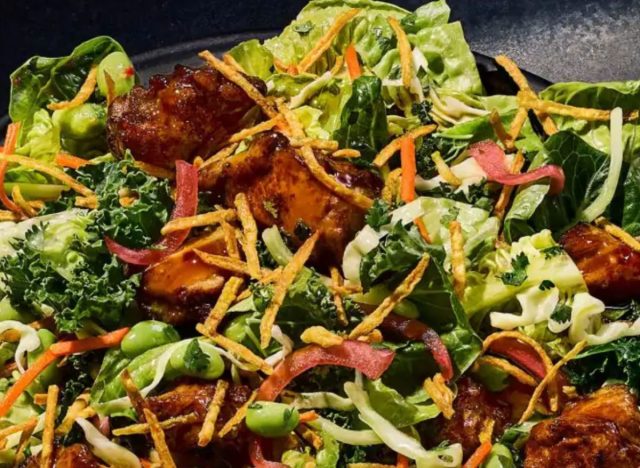
Per whole salad: 620 calories, 33 g fat (5 g saturated, 0 g trans fat), 1,330 mg sodium, 46 g carbs (8 g fiber, 26 g sugar), 35 g protein
You can order a half-salad at Panera, which we recommend, because this one packs a lot of calories, sodium and sugars. “It has nearly as much sugar as 6 Oreo cookies,” says Wirtz. On the plus side, it provides a healthy dose of dietary fiber, but we still consider it to be one of the unhealthiest restaurant salads you can order right now.
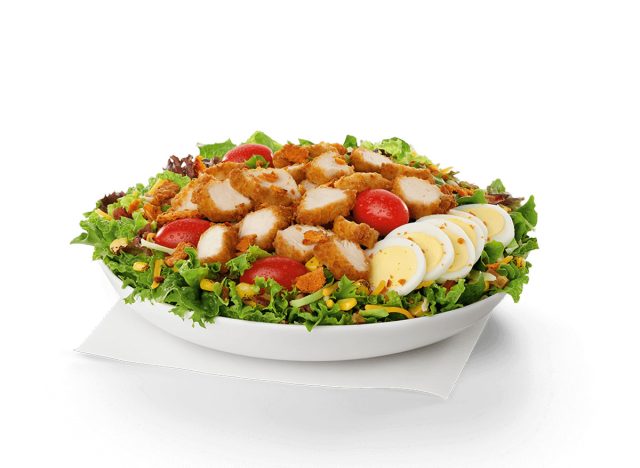
Per salad: 910 calories, 63 g fat (13 g saturated, 0 g trans fat), 1,880 mg sodium, 40 g carbs (5 g fiber, 10 g sugars, 45 g protein
Per serving of dressing: 310 calories, 32 g fat (5 g saturated, 0 g trans fat), 520 mg sodium, 3 g carbs (1 g fiber, 2 g sugar), 1 g protein
By now you may have detected a pattern: Cobb salads made with breaded chicken nuggets and drenched in dressing weigh heavily in calories, fat, sodium, and sometimes, sugars. The sodium in this salad is 100 milligrams higher than the recommended daily limit of 2,300 milligrams.
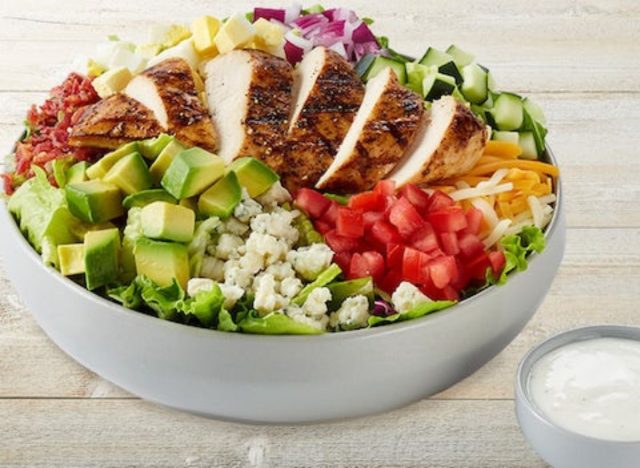
Per salad: 1,000 calories, 75 g fat (24 g saturated, 0 g trans fat), 2,520 mg sodium, 21 g carbs (9 g fiber, 8 g sugar), 66 g protein
A cobb salad like this is large and contains many ingredients, which can lead to a high calorie count, and explains why it’s one of the unhealthiest restaurant salads. Grilled chicken is often marinated in oil or a high-calorie sauce, adding to the calorie count. “The bacon, cheese, and dressing can also be high in sodium, which can lead to high blood pressure and other health problems,” says Best. “And while the salad includes vegetables, it may not contain enough fiber to promote satiety and prevent overeating.”
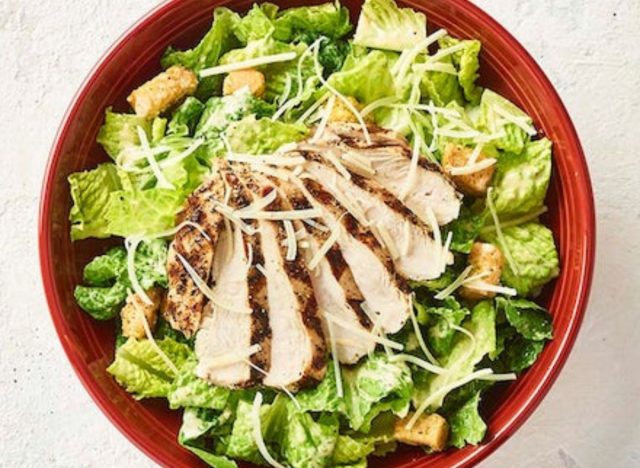
Per salad: 870 calories, 64 g fat (13 g saturated, 1 g trans fat), 1,610 mg sodium, 27 g carbs (5 g fiber, 5 g sugar), 47 g protein
“The chicken in this salad may be prepared with oil or butter, adding to the fat and calorie content of the meal,” says Best. “The dressing is typically high in fat as well, as it usually contains olive oil, Parmesan cheese, and mayonnaise.” If you have high blood pressure, take note of the high sodium from the dressing, croutons, and cheese.
To help take this one off the list of unhealthiest restaurant salads, you can always try ordering your dressing on the side in order to control these components a bit more.
